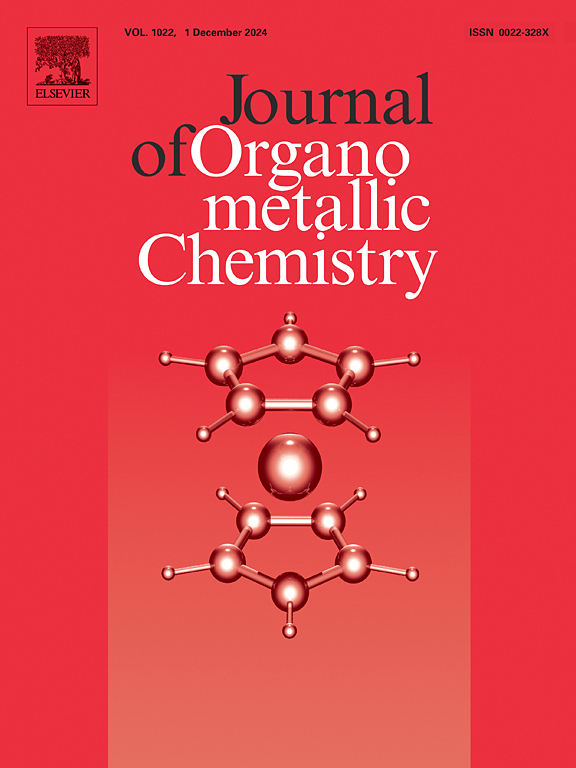Facile green synthesis of MoO2/BiOCl nanocomposite using Hibiscus rosa-sinensis leaf extract and its application in visible-light-driven oxidative transformations
IF 2.1
3区 化学
Q3 CHEMISTRY, INORGANIC & NUCLEAR
引用次数: 0
Abstract
This article describes a green approach for synthesizing MoO2/BiOCl nanocomposite using a combustion procedure with Hibiscus rosa-sinensis leaf extract as a renewable fuel source, which also acts as a reducing and stabilizing agent. The synthesized material is characterized using X-ray diffraction (XRD), scanning electron microscopy (SEM), energy-dispersive X-ray spectroscopy (EDX), X-ray photoelectron spectroscopy (XPS), transmission electron microscopy (TEM) and Fourier-transform infrared spectroscopy (FTIR), confirming the successful formation of the nanocomposite. The photocatalytic performance of MoO2/BiOCl nanocomposite was evaluated for visible-light-driven oxidative transformations of different aromatic amines to nitroarenes. The unique structure of MoO₂/BiOCl provides better accessibility to the reactant molecules, facilitating faster and more efficient oxidation. The advantages of this oxidative process are high catalytic efficiency, mild reaction conditions, recyclability, environmental sustainability, and producing nitroarenes in good to exceptional yields (67–95 %). The conversion of the compounds was validated using gas chromatography-mass spectrometry (GC–MS), 1H NMR, and 13C NMR. The results demonstrated that the MoO2/BiOCl nanocomposite exhibited enhanced photocatalytic activity compared to its components, attributed to the synergistic effects between MoO2 and BiOCl. The use of Hibiscus rosa-sinensis leaf extract in the synthesis is not only environmentally friendly and cost-effective but also contributes to the stability and efficiency of the nanocomposite.

芙蓉叶提取物制备MoO2/BiOCl纳米复合材料及其在可见光氧化转化中的应用
本文介绍了一种绿色合成MoO2/BiOCl纳米复合材料的方法,该方法以芙蓉叶提取物为可再生燃料源,同时作为还原剂和稳定剂。利用x射线衍射(XRD)、扫描电子显微镜(SEM)、能量色散x射线能谱(EDX)、x射线光电子能谱(XPS)、透射电子显微镜(TEM)和傅里叶变换红外光谱(FTIR)对合成材料进行了表征,证实了纳米复合材料的成功形成。考察了MoO2/BiOCl纳米复合材料在可见光驱动下不同芳香胺氧化转化为硝基芳烃的光催化性能。MoO₂/BiOCl的独特结构为反应物分子提供了更好的接近性,促进了更快、更有效的氧化。该氧化工艺具有催化效率高、反应条件温和、可循环利用、环境可持续性好、产率高(67 ~ 95%)等优点。用气相色谱-质谱(GC-MS)、1H NMR和13C NMR验证了化合物的转化。结果表明,MoO2/BiOCl纳米复合材料的光催化活性比其组分增强,这是由于MoO2和BiOCl之间的协同作用。在合成过程中使用芙蓉叶提取物不仅环保、经济,而且有利于纳米复合材料的稳定性和效率。
本文章由计算机程序翻译,如有差异,请以英文原文为准。
求助全文
约1分钟内获得全文
求助全文
来源期刊

Journal of Organometallic Chemistry
化学-无机化学与核化学
CiteScore
4.40
自引率
8.70%
发文量
221
审稿时长
36 days
期刊介绍:
The Journal of Organometallic Chemistry targets original papers dealing with theoretical aspects, structural chemistry, synthesis, physical and chemical properties (including reaction mechanisms), and practical applications of organometallic compounds.
Organometallic compounds are defined as compounds that contain metal - carbon bonds. The term metal includes all alkali and alkaline earth metals, all transition metals and the lanthanides and actinides in the Periodic Table. Metalloids including the elements in Group 13 and the heavier members of the Groups 14 - 16 are also included. The term chemistry includes syntheses, characterizations and reaction chemistry of all such compounds. Research reports based on use of organometallic complexes in bioorganometallic chemistry, medicine, material sciences, homogeneous catalysis and energy conversion are also welcome.
The scope of the journal has been enlarged to encompass important research on organometallic complexes in bioorganometallic chemistry and material sciences, and of heavier main group elements in organometallic chemistry. The journal also publishes review articles, short communications and notes.
 求助内容:
求助内容: 应助结果提醒方式:
应助结果提醒方式:


